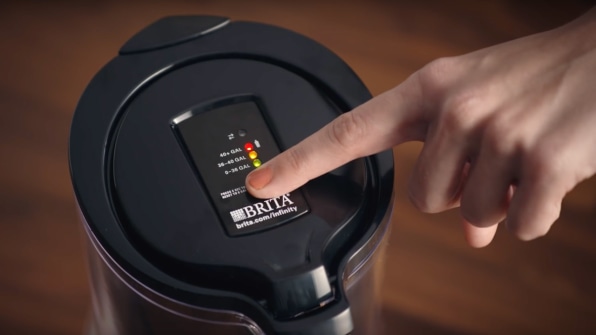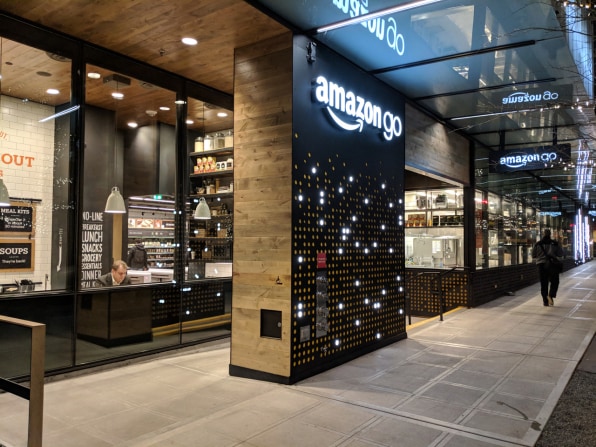Amazon the Button Has Changed Again
Amazon Dash buttons never seemed like a very practiced idea for anyone but Amazon. When the devices were announced on April 1st 2015, some suspected they were an April Fools' joke. The buttons extended Amazon's reach into your home in a mode that seemed both silly and suspicious. These little internet-continued buttons, each assigned to a specific production, like garbage bags, allow you guild more with just a tap. The future of retail! But upon closer inspection, the buttons lacked transparency about pricing, and didn't always guarantee you the lowest available price. They covered your house in logos. And how often do you lot really order new Burt's Bees lip balm, anyway?
On Friday, the company confirmed toFast Company that it has stopped selling Dash buttons altogether. Erstwhile Dash buttons volition continue to work, but the initiative as we know information technology is done.
Amazon isn't saying much about why it's canceling the buttons, merely their failure may reveal something key nigh Amazon's future strategy. Even though the value proffer they offered to users was ease, Dash buttons still added too much friction to the purchasing process. And the future of Amazon is near selling things without the customer having to log on and buy them.
The buttons weren't fast enough for customers
Above all else, Dash buttons underdelivered on their promise. Their appeal–printing push, get affair–was obvious to anyone who has found themselves without toothpaste or toilet paper. But unlike most physical buttons in our world, which take instantaneous results like turning on the A/C in the car or making Mario jump, the merely thing you could count on when yous hit a Dash button was a two-twenty-four hours await.
As of 2017, Amazon was selling thousands of items to customers via Dash buttons each day. That sounds similar a lot, until you lot remember the company'due south scale: Amazon currently has 100 million Prime members, and it sold millions of Dash buttons before information technology discontinued the program.

They weren't like shooting fish in a barrel enough for Amazon, either
From a UX perspective, Dash buttons are outmoded–because Amazon has already figured out how to tackle the delay betwixt realizing you're out of toilet newspaper and really getting it.
Amazon's Subscribe & Relieve system has let customers auto-club appurtenances for years now. But the company has launched another, fifty-fifty more friction-less initiative dubbed Replenishment Services, which can role you with your money with unprecedented efficiency. From Brita water filters to HP inkjet printers, the Replenishment Services program invites manufacturers to broil auto-ordering correct into their cloud-connected products. Once a customer sets up Replenishment Services on a device, they never need to guild replacement toothbrush heads or coffee pods once more. The transaction is automatic. Amazon reports that Replenishment Services purchases have doubled year-over-year.

Amazon doesn't necessarily need to proceeds more traction in your domicile to grow, anyway.
For Amazon to continue expanding, it needs to diversify, and have its services available in places where they are non. Information technology's this strategy that led to the 2017 acquisition of Whole Foods–but more importantly, the launch of Amazon's showtime Go store in 2018 and a newly announced plan to open a third sub-brand of grocery stores early next year.
Having conquered online shopping, Amazon conspicuously sees a big opportunity to reduce payment friction (the time and mental endeavor it takes to buy something) in the physical, brick-and-mortar space. That may exist easier for a tech company like Amazon, which owns ane of the biggest piles of cloud-based computers in the world, to disrupt than peers like Walmart. Amazon Become stores allow Amazon to be its ain deject client, leveraging AI to let people to buy things in a store simply by grabbing them off the shelf and walking out. No cashier–or buttons, or two-mean solar day await–required.
With Replenishment Services, an online customer never needs to choose to purchase a product online again. With its Get stores, Amazon is creating a similarly friction-less experience, but in the real world.
But is friction-costless shopping adept for anyone except Amazon?
Amazon more or less describes its strategy in an official statement on the demise of the Dash button programme:
"…With Dash Replenishment, nosotros've launched hundreds of devices globally that automatically reorder essentials and so customers don't take to recollect at all almost restocking….We've as well seen customers increasingly using programs similar Alexa Shopping, which provides a hands costless shopping experience, and Subscribe & Salvage, which lets customers automatically receive their favorite items every month."
While the ease and convenience of these programs is certainly appealing–and by all ways, very convenient–information technology might not be good for consumers.
Enquiry shows that 84% of Americans underestimate the coin they spend on digital subscription services. And people can spend as much as 100% more than with a frictionless credit menu than they would with cash, which at least has the protective effect of literally causing people pain when they office with it. Given that wages have been practically stagnant for almost people since 1979, consumers should exist thinking almost each purchase more, not less.
In other words, the Amazon Nuance button was ever a bad idea. But the hyper-optimized purchasing model that's emerging in its place could be far worse.
Source: https://www.fastcompany.com/90314115/amazon-is-about-to-take-even-more-of-your-money-and-you-wont-even-notice
0 Response to "Amazon the Button Has Changed Again"
Post a Comment